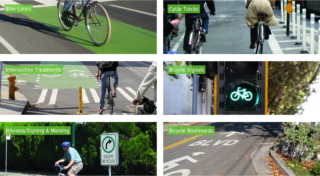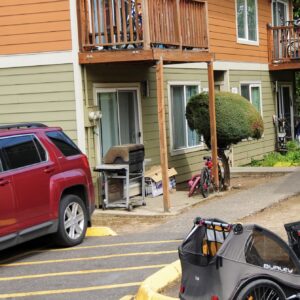
(Photos: NACTO)
After a year and a half of lobbying, the Oregon Department of Transportation has formally recommended that its street designers look for ideas in one of the country’s most progressive bikeway design books.
The Urban Bikeway Design Guide by the National Association of City Transportation Officials was one of the country’s first official documents to include design elements like protected bike lanes, bike boulevards, floating bus stops and bike-specific traffic signals. Some of its concepts are already in Oregon’s in-house bikeway design guide, but NACTO has asked allied states and cities to endorse its guide in order to lend legitimacy to the designs in less progressive states.
Virtually all of these designs are inspired by the Dutch streets manual and repurposed for U.S. streets — which tend to be wider, with more attention to people with disabilities, more on-street parking and traffic signals instead of roundabouts. (Another feature of U.S. streets: about three times as many traffic deaths.)
Preceding Oregon in endorsing NACTO’s guide were Washington, Massachusetts, California, Colorado, Delaware, Georgia and Virginia. Also, 54 cities (including Portland), one county and the Federal Highway Administration have signed on.
Advertisement
The entire effort has been a sort of proxy war by street-design progressives against conservative members of the American Association of State Highway and Transportation Officials. AASHTO is a private association, governed mostly by engineers at state DOTs, that publishes the country’s most widely used design manuals. AASHTO and its counterparts on the National Committee on Uniform Traffic Control Devices (another private engineers’ association that has been granted regulatory power over traffic signals and on-street markings by the federal government) has spent the last few decades ignoring or rejecting the sorts of bike infrastructure used in bike-friendly cities in Europe, Asia and elsewhere.
Back in April 2014, when Massachusetts and California endorsed the NACTO guide, we listed an endorsement of the NACTO guide among five good biking ideas that Oregon could lift from other states. It’s great news that the state has done so.
In the meantime, of course, national norms have continued to shift. The Massachusetts DOT is about to release a bikeway design guide that goes well beyond NACTO to include engineering-level detail for newer Dutch-inspired designs like protected intersections. California is preparing to follow suit.
NACTO is working on the next edition of its Urban Bikeway Design Guide, and AASHTO officials say they’re likely to include protected bike lane guidance in their next bike guide, due in 2017.
Oregon, too, is preparing to circulate a new version of its statewide biking and walking ‘modal plan’ for public comment. It’ll be interesting to see if that plan endorses one of the signature concepts behind NACTO’s bike guide: that protected bike lanes, not painted stripes, are the appropriate treatment for bikes on high-traffic or high-speed streets.





So when will the road-widening stop for Washington County? I can think of just two roads in that county that have recently become more narrow.
I was driving on SW 175th on Sunday – an area that’s changed a lot since I was last there – and was surprised by how narrow the new road is. There is NO shoulder, so biking on it would seem quite dangerous. I agree that narrow lanes are good in that they tend to slow drivers’ speeds down, but when the actual roadway has no shoulder, you can pretty much kiss it goodbye for biking. (And yes, I’m a “take the lane” sort of guy, but not with the hills and blind curves on that particular road).
I’m told that a new high school is going in on that corner of 175th and Scholl’s, but at least Scholl’s seems to have much better bike lane markings now (than when I used to ride on it).
Bethany Blvd was recently widened to 4 car lanes from 2. The Oak Hills neighborhood was very opposed to the widening.
Yeah, and it is totally unnecessary. Traffic flowed just fine when it was two lanes with a middle turn lane for months, while it was still under construction. Now that it’s a 4 lane, everybody speeds on it, and if you go the speed limit people just race around you.
According to the plans, the bike lanes are the bare minimum 5 feet, but I doubt they are even that wide in reality.
Just went and looked at the bike lanes there. I should have brought a tape measure, because I’d be surprised if the lanes are even 4 feet wide. If a county goes through a whole public approval process prior to road widening that includes published plans, can they just shrink the bike lanes later? Is that even legal?
I thought the state engineering standards called for bike lanes to be a minimum of six feet unless the total right of way is too narrow, in which case they can be as narrow as four feet. If there is more than one travel lane in each direction, the right of way is obviously not too narrow, so this is clearly a substandard build. Color me unsurprised; I experience all sorts of stuff that is below even the paltry AASHTO standards that Oregon adopted decades ago.
I would love to see “NACTO 2.0” address some of the more realistic situations we encounter, such as lane drops and merges, or what I call “mixing zones” where bike lanes encounter multiple intersections in a short span (and bicyclists otherwise can’t avoid ‘mixing’ with car traffic). I’m encouraged by this, but here in CA we endorsed NACTO a while back, but you still watch city and county engineers tow the same old MUTCD line (keep the bike lanes narrow and Far To(o) Right at all times/costs).
The NACTO guide is flawed (still includes mixing-zones, for example), but this is a good first step.
Now we can ask ODOT where in the NACTO guide it recommends removing bike lanes for safety.
Actually, if you rode my commute you would probably determine that the sections without bike lanes are the most comfortable ones. I’m in a bike lane on Saltzman, Cornell, Valeria View, Barnes, Canyon Ct, 14th Ave, Marshall, Broadway, and Multnomah. Yep, that’s pretty much an exact match of the worst parts of my commute.
It probably depends on where you are going and what the alternatives are.
Why the “progressive” vs “conservative” nomenclature?
What is “progressive” supposed to mean here? I hope it’s not simply a case of some adopting the word “progressive” as a marketing play, as if to suggest that failure to agree with them means that you’re backward.
I can’t imagine how being in favor of using this preferred manual aligns with other generally politically progressive themes…if we’re using the word “progressive” properly.
Good question! In this context I’m musing “progressive” to mean “supportive of changes in policy and practice, especially those that lead to equitable outcomes across demographic groups” and “conservative” to mean “hesitant to make rapid changes to policy.”
As many people have pointed out, the “conservative” value of small government (as the word is usually used in politics) actually aligns pretty well with the “progressive” value (in the transportation world) of decentralizing design decisions and not dedicating massive amounts of private land to freeways, etc. And of course there are lots of other ways transportation issues split along something other than the usual political lines.
Yes…I have often described this political spread as not a linear left to right but as a hoop or circle, as one travels to the “far end” of our two primary political parties you often start edging back to the other’s far end…there is overlap at the ends and in the middle…at easy until the “independent party ” established itself 😉
Thanks for the response! Though I want to quibble with “progressive” (it places a positive value judgment, ie., “equitable”), I will not. I was curious on use and you answered that. Thanks, again.
It has nothing to do with politics. In fact, it is the political definition of “progressive” and “conservative” that has been subverted. A conservative engineer is resistant to any considerations that go against the norm. They won’t try a road diet, or a cycle track because it “has never been done here” or they view it as risky. A progressive designer will be more likely to try new designs.
Conservative is hardly to be resistant for the sake of being resistant, though. And to be progressive is hardly to be willing to try something new simply because it’s new.
NYC offers a great 37 page NATCO overview free as a PDF file here:
http://www.nyc.gov/html/dot/downloads/pdf/2012-nacto-urban-street-design-guide.pdf
Your characterization of AASHTO and the National Committee on Uniform Traffic Control Devices is not completely correct. AASHTO is governed by the Chief Executives of the 50 state DOT’s as well as DC and Puerto Rico. Some of the CEO’s are engineers and many are not.
AASHTO’s Standing Committee on Highways, which has responsibility for the Green Book among other things, is comprised of the Chief Engineers of the state DOT’s
Federal Highway Administration staff writes the Manual on Uniform Traffic Control Devices. The National Committee on Uniform Traffic Control Devices is completely advisory to the FHWA.
Too bad the news won’t actually make it to Salem & Keizer where ODOT is headquartered. That includes ODOT staff.
After spending a couple weeks in France (on my own bicycle) the whole “traffic lights instead of roundabouts” thing is insane. They flow so much better than stoplights, especially outside of the super-dense cores of places like Paris.